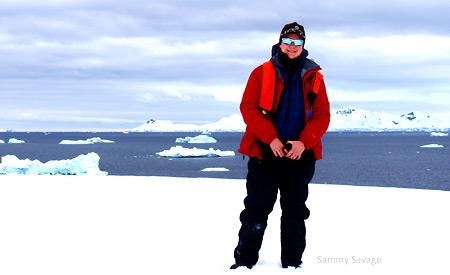Few people can say they have been to the bottom of the world, but a Powell River teen is one of them.
Samantha Savage journeyed to Antarctica during her winter holiday as part of a Students on Ice expedition which guides students and educators from around the world to the North and South poles.
The Brooks Secondary School grade 11 student first heard about the organization while participating in Brooks’ Leadership Ecology Adventure Program from another student who had gone to the Arctic and had brought back pictures. The photographs inspired Samantha.
She and her parents decided to pursue the trip to the Antarctic because of its exotic appeal, she said. She raised $15,000 to pay for the trip through her parents, community support and working part-time.
Eighty-five students and instructors, from high schools and universities, met on the last day of the year in Ushuaia on Argentina’s Terra del Fuego, South America’s most southern tip. From there they set sail for Antarctica on their icebreaker-based expedition.
Sammy said that everyone on the trip was friendly and open to help others. The majority of students were from Canada and the United States, but there was also a girl from Sweden and a boy from India.
The Antarctic Treaty System is a collection of agreements from the 1950s that ensure international cooperation, despite overlapping territorial claims, and the sharing of research collected “on ice.”
“It was really nice to go down and see that the Antarctic treaty is not just protecting a barren wasteland—it’s protecting animals and their habitats,” she said.
The students drilled holes in the ice and learned about other field research techniques used in gathering data for studying climate, ice formations and the South Pole’s unique ecosystems. They encountered four different kinds of whale—orca, humpback, minke and fin. While sailing across Drake Passage, Sammy said she was amazed by the number of albatross and petrels. “I wasn’t really a bird person before this, but now I look at seagulls and they are kind of like mini-albatross,” she added.
Academics, photographers and South Pole experts spoke about environmental and climate issues facing the continent’s peninsula.
“It was more like we saw what we’d be losing if we continued to do what we have been doing,” she said.
She explained that the ice on the Antarctic Peninsula is melting at a considerable rate, but on the eastern half of the continent things are not changing as much.
Sammy learned about the consequences the melting ice is having on the ocean’s pH level, disrupting the ecosystem’s algae and diatoms (a common type of phytoplankton), which she said have a greater impact capturing carbon than the earth’s forests.
On the lighter side, a trip highlight for Samantha was taking a penguin dip in Charlotte Bay, where the water was a bracing 1.8° Celsius. “We all did it,” she said, adding that she and her fellow travellers probably gave the expedition’s doctor a heart attack.
She returned after two weeks with stories of her polar experience and a conviction to further promote recycling and environmental awareness. She said carbon offsets were being purchased on her behalf to make up for her lengthy travel and that the experience has left her hopeful for the world.
“I would definitely recommend the experience,” she said, leaving her comment ambiguous as to whether she meant travel to the Antarctic or taking an icy dip with penguins.



